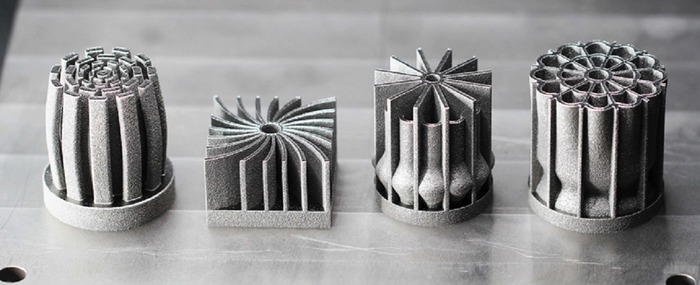Introduction
3D-Printed Heat Sinks emerge as a groundbreaking innovation designs that optimize heat dissipation while reducing weight and material usage.. Additive manufacturing, commonly known as 3D printing, allows for the creation of highly complex and customized heat sink Unlike traditional machining or casting methods, 3D printing enables engineers to develop intricate lattice structures, microchannels, and porous surfaces that enhance cooling efficiency. These heat sinks are widely used in industries such as aerospace, automotive, high-performance computing, HVAC, and industrial electronics, where thermal performance is critical. With advancements in metal 3D printing technologies, materials such as aluminum, copper, and titanium can be utilized to enhance thermal conductivity and mechanical durability. This technology not only improves heat transfer efficiency but also contributes to sustainability by minimizing material waste and energy consumption. As industries strive for smarter, lighter, and more energy-efficient cooling solutions, 3D-printed heat sinks are set to redefine the future of thermal management. As electronic devices, power systems, and industrial machinery become more compact and powerful, the demand for efficient thermal management solutions has surged. Traditional heat sinks, which play a crucial role in dissipating heat from electronic components and mechanical systems, often face design limitations due to conventional manufacturing constraints. This is where
Key Advantages of 3D-Printed Heat Sinks
Complex Geometries for Enhanced Cooling
Traditional heat sinks are often limited to simple fin structures due to manufacturing constraints. However, 3D printing allows for the creation of intricate, highly optimized designs such as lattice structures, microchannels, and porous surfaces that significantly increase the heat dissipation area. This results in improved cooling efficiency and better thermal performance in applications requiring high heat transfer rates.
Lightweight and Compact Designs
Weight is a crucial factor in many industries, including aerospace, automotive, and portable electronics. 3D-printed heat sinks can be designed with optimized material distribution, reducing unnecessary bulk while maintaining structural integrity. This makes them ideal for applications where weight reduction is essential without compromising cooling efficiency.
Customizable Heat Sink Structures
Unlike mass-produced traditional heat sinks, 3D printing enables manufacturers to design heat sinks tailored to specific devices and applications. Engineers can customize parameters such as fin spacing, airflow channels, and surface textures to match the exact thermal requirements of a given system, leading to improved cooling performance and energy efficiency.
Optimized Material Utilization
Traditional machining and casting processes often result in significant material waste. In contrast, additive manufacturing uses only the required amount of material, reducing excess scrap and lowering overall production costs. This optimization contributes to sustainability efforts and minimizes the environmental impact of manufacturing processes.
Integration of Advanced Cooling Features
3D printing allows for the seamless integration of advanced cooling features that are difficult or impossible to achieve through conventional methods. These include embedded cooling channels, high-density fin arrays, and complex multi-layered structures that enhance heat dissipation by increasing surface area and airflow efficiency.
Faster Prototyping and Production
Product development cycles in thermal management often involve extensive testing and modifications. 3D printing enables rapid prototyping, allowing engineers to quickly iterate and refine designs without the time and cost constraints of traditional manufacturing. This accelerates innovation, reduces lead times, and enhances the overall efficiency of the product development process.
Use of High-Performance Materials
Advanced 3D printing technologies can work with high-performance materials such as titanium, aluminum, copper, and specialized composite alloys. These materials provide superior thermal conductivity, corrosion resistance, and mechanical strength, making 3D-printed heat sinks suitable for demanding industrial applications, including aerospace, power electronics, and high-performance computing.
Enhanced Performance in Extreme Conditions
Certain industries, such as aerospace, defense, and high-performance computing, require heat sinks that can withstand extreme temperatures, high mechanical loads, and harsh environmental conditions. 3D-printed heat sinks are engineered with superior thermal resilience, ensuring reliable performance under extreme operating conditions.
Reduced Manufacturing Costs for Complex Designs
Producing highly complex heat sink structures using traditional manufacturing methods often requires multiple machining processes, assembly steps, and additional labor costs. 3D printing eliminates many of these steps by producing the entire component in a single build process, reducing production costs and minimizing the need for post-processing.
Eco-Friendly and Sustainable Manufacturing
Sustainability is a growing concern in modern manufacturing. 3D printing offers an environmentally friendly alternative by reducing material waste, lowering energy consumption, and enabling more efficient production techniques. The ability to manufacture heat sinks on demand also reduces inventory costs and minimizes excess production, contributing to a greener manufacturing approach.
Conclusion
3D-Printed Heat Sinks represent the future of thermal management, offering unparalleled design flexibility, enhanced cooling efficiency, and sustainable manufacturing benefits. As industries continue to seek lightweight, high-performance, and cost-effective thermal solutions, 3D printing technology will play an increasingly crucial role in revolutionizing heat sink design. By embracing this cutting-edge technology, companies can achieve superior thermal performance while reducing manufacturing costs and environmental impact. In sectors like aerospace, automotive, electronics, and renewable energy, the demand for high-performance, space-saving, and cost-effective heat sinks continues to grow. 3D printing not only meets these demands but also enhances the manufacturing process by reducing production costs, shortening lead times, and minimizing waste. As metal 3D printing technologies evolve, the adoption of 3D-printed heat sinks is expected to accelerate, driving innovation in smart cooling solutions and energy-efficient systems. In the near future, 3D-printed heat sinks will become a standard solution in high-performance thermal management, paving the way for next-generation cooling technologies that enhance the performance and lifespan of electronic and mechanical systems. By embracing this revolutionary approach, industries can achieve greater energy efficiency, reduce environmental impact, and unlock new possibilities in product design and functionality.

